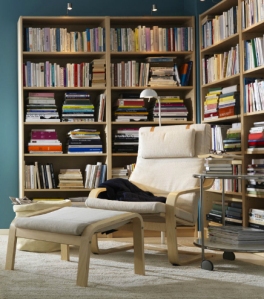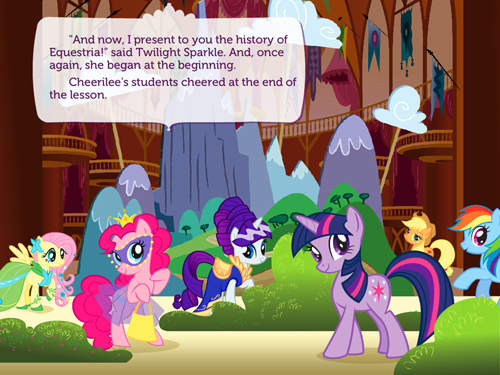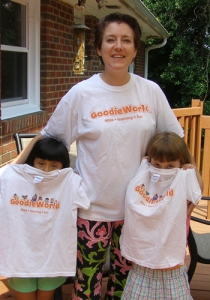
Dream library, IKEA version
As long as I can remember, I’ve had the dream of one day owning a house big enough to hold a room with a dedicated library of all my books, complete with one of those rolling ladders to allow me to reach the high shelves. This dream personal library has a velvet chaise lounge with a beautiful bronze floor lamp next to it, and a fireplace, bear rug, the whole luxurious nine yards.
I made a startling realization the other day: if we abandon the fantasy of the chaise lounge/floor lamp/fireplace, I’ve already got the dream library, since I have more than 600 books in my Amazon Kindle Cloud Drive and more than 200 iOS apps, half of them book apps.

Dream library, Kindle version
I write this post today because I’ve been hearing the following statement lately, from a variety of people:
“I like ebooks and all, but I prefer the feel of a real book in my hands.”
While I don’t really care if these folks hold on to their dead tree books as long as they like, I think they’ll eventually change their minds. Here’s why.
Ebooks Are Convenient
Between all my gadgets (Android phone, two iOS devices and a Kindle Touch) I have access to hundreds of books (many obtained free, or at discount prices) in my favorite genres. I send cookbooks, craft books and other how-to or multimedia books to the Kindle Reader on my iPad; mysteries, business books, chick lit and other text-based books I want to read soon to the Kindle Touch, and the rest (books I may want to read someday) to the Kindle Cloud Reader, which effectively stores them in the cloud for free. I use the Kindle Reader on my phone when I don’t have access to one of my other reading devices and I’m unexpectedly caught with an extra few minutes in my day. I like having my library accessible anytime, anywhere–I don’t have to be on the velvet chaise lounge after all.
Page turns are managed with a single touch to the right-hand side of the screen, and I can get to any place in the book easily, within a couple of touches.
Ebooks Enhance the Experience of Reading
I love the ability to touch a word I don’t know and get the definition instantly. I love that the Kindle system keeps my place no matter which device I’m using. I also love the way many of the book apps I have for my kids not only hold their interest but encourage literacy and retention through interactive features (one company that does this especially well is Oceanhouse Media with word highlighting and the ability to hear a word aloud when it’s pressed in their storybook apps).
Ebooks Are Lighter and Easier to Maneuver
I’ve been reading the Song of Ice and Fire series by George R. R. Martin. Because I am a cheapskate, I decided to read the third book (A Clash of Swords) in paperback, since I found it at my local used bookstore and purchased it with store credit. This book, in mass market paperback form, is heavier and bulkier than my Kindle Touch and won’t stay open without my propping it with a heavy object, so it’s difficult to hold with just one hand. I like the fact that I can store all the ebook versions of the others in the series (and hundreds of other books) on a single device that weighs less than the small-format paperback.
Ebooks Are Less Wasteful
Lately when I hold a print book, especially a hardcover, I’m hit with the overwhelming feeling of wastefulness. There’s something pretty unpleasant about the fact that the book I hold in my hands is a real, tangible slice of what used to be a living thing, processed and assembled for the sole purpose of my entertainment or learning. I offset this as much as I can by taking physical books I don’t want anymore to my local used bookstore, then offering the ones they don’t want on PaperbackSwap.com, but the fact is: printed books use up resources (paper, ink, glue and more) that no longer need to be expended for the same entertainment or educational value.
Ebooks Can be Updated Much Faster, and at Less Cost
Non-fiction books in print form eventually become outdated. Information changes and evolves as humans gain more knowledge about a topic, or when materials or ways of doing things are improved. But let’s be honest: most non-fiction print books will be truly useful for only a fraction of their lives. After that, the next edition replaces it–at significant cost. Textbook publishers have profited from this with great success for many years–at the expense of both teachers and students.
It’s time for ebooks to become the preferred way to distribute educational materials and other non-fiction content, which can be updated quickly and redistributed almost instantly, to all users of the material, with no expending of the tangible resources needed to print a new edition.
However, Ebooks Aren’t Perfect
For me, the five reasons above are pretty compelling for the shift to digital. But there are some things about ebooks I don’t like as well. These shortcomings aren’t enough to send me back to paper, but they are worth mentioning:
- The Kindle ‘Farthest Page Read’ Feature Needs a Reset Button. The ability of Amazon’s Kindle devices to keep my place is great, but occasionally I accidentally make my way to a later page that doesn’t actually reflect where I am in the book. When this happens, keeping my place manually becomes a pain in the neck. I’d love to see a way to reset this, but I imagine it won’t happen, since the addition of this feature would make it much easier for spouses and other family members to share books on the same family of devices. But since I let my kids and spouse share my print books, I’d sort of like to share my ebooks with them too, in a hassle-free way. Come on, Amazon!
- Prices of Ebooks from the Big Publishers are Too Expensive. Books coming from the big 6 publishers are priced according to their artificial and rapidly-crumbling world of print scarcity and their hardback-to-trade-paperback-to-mass-market-paperback release schedule. This is archaic and needs to change. Why should the ebook version of a title ever cost more than the mass market paperback would? It all comes down to greed, and an over-reliance of the old way of doing things. Eventually these outdated practices will put many of these publishers and retailers (remember Borders?) out of business.
- Ebook Lending Needs to Be Improved. It’s nice that I can lend one of my Kindle books to someone else (if the publisher allows it), but I can only do it once. After that, the book can’t be lent again. I don’t mind the restrictions of one-person-at-a-time and my own inaccessibility during the lending period (since these are in force for my print books too) but let’s remove the artificial restriction of once only, and let me lend a book I’m finished with over and over if I choose.
- Ebook Devices Aren’t Durable or Affordable Enough. When iOS devices and other ebook readers are able to withstand normal wear and tear by school-aged children (i.e. being dropped on the floor) and are cheaper than $50, we will see a true revolution. Until then, they aren’t practical enough to replace most of the printed books in my house, which are now children’s books. Plus an entire segment of the population (the lower middle classes and below) have little to no access yet.
So, what I’m saying is: in spite of the drawbacks, ebooks have become just as ‘real’ to me as print books are. I love them both, but I’m not buying many print books anymore. And eventually (probably within the next five years or so) most of the rest of you will be saying the same thing.












